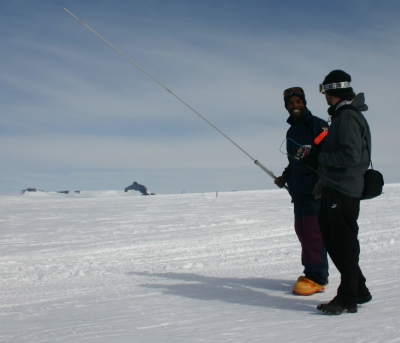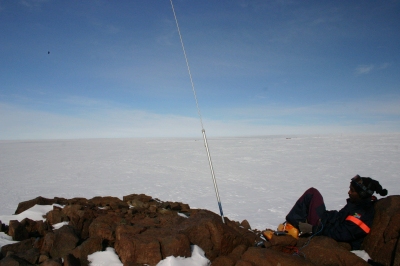I-TASC expedition 2006/2007
So today I decided it would be great to try out the Very Low Frequency (VLF) antenna and receiver with Remmy. The VLF receiver allows you to tune in to, and listen, to the earth’s ionosphere. It is the type of tuner that people use to listen to the auroras, but it conjures up some interesting sounds at any time. Remmy and I had renovated a VLF antenna from the base just 2 days ago. It was sitting on the roof of the base but got destroyed in a storm. So we located an extra filament and reconstructed it. Then we made a nice antenna cable to run between the receiver and the antenna, and an earth cable.

The VLF antenna itself is about 3 metres long and looks like a long fishing rod. We grabbed it and the receiver and headed off after lunch to a nice quiet spot about 800 metres away from the base. The problem with VLF is that if you are close to power sources (cables etc), the receiver will pick it up and all you will hear is hum. So we got as far away from power sources as was practical and dug the earth cable into some rocks. We then connected it all up and plugged in the headphones. It was exciting as Remmy is a space scientist specialising in VLF and he had never heard live VLF sounds before. The little INSPIRE VLF receiver worked wonderfully and we could listen to the sferics. They sound (in Remmy’s words) like fat frying in a frying pan. We were hoping to hear some other sounds like the fabled whistlers, but these are rare, especially this time of year. So our tests were relatively short lived, we really went to test the set-up and see how it operated. Next, we will do some longer soundings and record the output. The place we chose to set it all up is pretty beautiful. About 800m from the base and overlooking a huge plateau. There were plenty of rocks for us to lie comfortably on, the sun was out and the wind was almost non-existent. It was a clear and hot day. The scene cut quite a mix of the familiar and the bizarre, and I had to tell myself I must remember this moment as it’s not every day you see a space scientist sitting on a rock fishing for rare radio waves.

Remmy explained to me quite a lot about VLF. One of the most interesting things is that VLF travels along the earth’s magnetic field, which means you have points of mirror-like reflection. For example, the sounds we were hearing could have been occurring directly above us in the earth’s ionosphere, but equally, they could have been occurring in the Northern Hemisphere and being communicated here by the earth’s magnetic field. This is a very interesting phenomenon, peculiar to VLF, and it has been suggested that VLF communication could exploit the earth’s magnetic field in a similar fashion and produce a highly efficient long range communications system. Additionally, it was interesting to learn about the rarity of whistlers (caused by large electromagnetic events such as nuclear explosions or lightning strikes), and other sounds that can cause interference with VLF observations and cause problems for scientists (such as emissions from submarines).
In the evening we will go back and record some audio from the antenna which will be used in an installation r a d i o q u a l i a has in Italy in April. In the meantime, it was a nice afternoon chatting and mixing art and science in equal measure.
